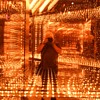Posted 9 years ago
Hawl
(8 items)
I bought this camera yesterday in Holland for 220 euro's.The retailer couldn't (wouldn't?) give any information about its history. To my surprise however I found the camera (with a different lens) as a Christie's object back in 2002. So I presume that H.Martin was a well respected builder at the time.
http://www.christies.com/lotfinder/lot/tailboard-camera-3907192-details.aspx?intObjectID=3907192














The auction camera is slightly different than yours. For example, your camera has a roller blind shutter mounted between the lens and front board. There are also some minor differences in the choise of wood and construction details. This is not unusual as minor design tweaks occur over the years and the possibility that Martin cameras were made by other builders.
I checked my library and only found one listing for H. Martin. The thing we do not know is if Martin was a builder, store, or 'jobber' who might have hired other makers to create cameras for his name. However, the majority of cameras like this are built other makers and then private labeled.
Overall, this design is what we refer to as "Chambre De Voyage" (French for "field camera"). It is a generic reference for a common style of field view camera sold in France from the 1890s to the 1930s: also known as a "Continental - styled View Camera" or simply "Continental View."
Popular on the European continent, the majority of these cameras had the same basic features ranging from simple to elaborate. The Chambre De Voyage is mainly a tailboard design (fixed front with focusing back) employing a sliding wooden panel to lock the bed. Although straight forward in design, there were many variations with features such as full rack and pinion focusing, slotted-keyed mounting holes, fine focusing, interchangeable lens boards, shifting front standard, and rotating bellows about the front lens collar to change the picture orientation (portrait vs. landscape).
An interesting aspect of these cameras is the bellows. Many versions had colorful bellows with corners reinforced with a contrasting color. I have seen examples with blue, purple, pink, red-you name it-bellows. Years ago, I owned a 9 x 12 cm format version with a forest green leather bellows.
The basic story is that these cameras were almost all made in the Alsace region of France-Germany by cabinet makers who would turn them out during their off-season to keep the shops going and labor employed. Most were nameless but some had name-plates usually of the store, retailer or distributor -- rarely any big names.
Occasionally a name-brand maker (e.g. Derogy) would produce a better quality version for people who wanted to spend more. Wood was whatever grew nearby, usually adequate quality but not great. Workmanship was competent but not great. - Rob
thanks Rob, very interesting!